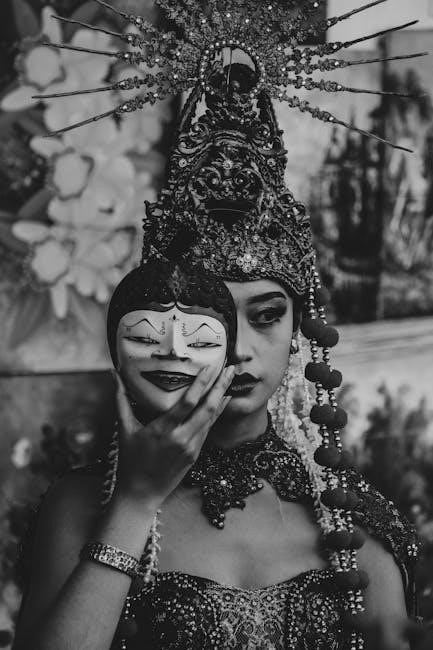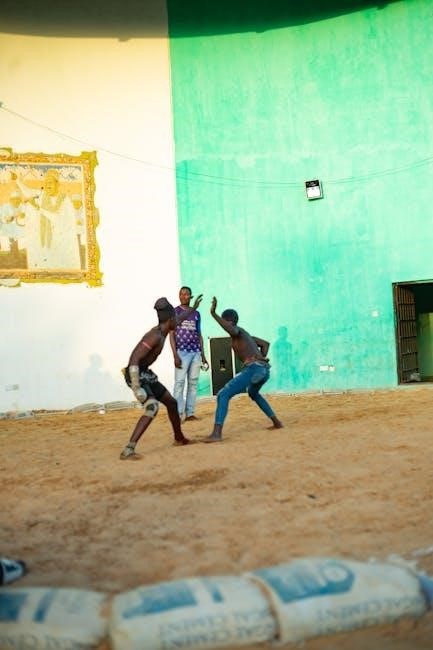Mira Jacob’s debut novel, The Sleepwalker’s Guide to Dancing, explores the complexities of cultural identity and family dynamics through the lens of an Indian-American family in New Mexico.
Blending humor and emotional depth, the story delves into themes of belonging, memory, and the struggles of navigating two worlds, offering a powerful and moving narrative experience.
1.1 Overview of the Novel
The Sleepwalker’s Guide to Dancing by Mira Jacob is a vivid exploration of family, identity, and cultural conflict. Set against the backdrop of 1979 Salem, India, and New Mexico, the novel follows Amina, a young woman caught between two worlds. The story unfolds with an explosive family encounter at her grandmother’s house, unraveling a web of secrets and misunderstandings. Amina’s journey to confront her family’s past reveals the complexities of belonging and the power of memory, blending humor with emotional depth.
1.2 Author Background: Mira Jacob
Mira Jacob is an Indian-American author and illustrator, known for her insightful exploration of identity, culture, and family dynamics. Born to Indian immigrant parents, her experiences heavily influence her writing. Jacob gained acclaim with her debut novel, The Sleepwalker’s Guide to Dancing, and later with her graphic memoir, Good Talk (2019), which delves into conversations about race, sexuality, and identity. Her work often reflects the complexities of navigating multiple cultural worlds, resonating deeply with readers seeking authentic, relatable narratives.
Plot Summary and Key Themes
The Sleepwalker’s Guide to Dancing intertwines family dynamics and identity struggles, focusing on Amina’s journey to unravel her family’s past and cultural heritage, exploring themes of memory and belonging.
2.1 The Storyline: Family, Identity, and Conflict
The Sleepwalker’s Guide to Dancing follows Amina, a young Indian-American woman, as she navigates a complex web of family secrets and cultural expectations. Returning to her childhood home in New Mexico, Amina confronts tensions between her parents and brother, while grappling with her own sense of identity. The story unfolds against a backdrop of generational conflict, exploring how memories and misunderstandings shape relationships. Amina’s journey reveals the fragile balance between tradition and modernity, highlighting the challenges of belonging to two worlds.
2.2 Themes Explored: Culture, Belonging, andMemory
2.2 Themes Explored: Culture, Belonging, and Memory
Mira Jacob’s novel delves into themes of cultural identity, belonging, and the power of memory. The protagonist, Amina, struggles to reconcile her Indian heritage with her American upbringing, reflecting the broader immigrant experience. Memory plays a pivotal role, as past conflicts and misunderstandings shape the present. The novel explores how cultural traditions and modern expectations collide, creating tension within families. Through these themes, Jacob examines the universal quest for belonging and the enduring impact of memories on identity and relationships.
The Protagonist’s Journey
Amina’s journey in The Sleepwalker’s Guide to Dancing is a poignant exploration of identity, as she navigates cultural duality, family conflicts, and self-discovery, seeking her place in the world.
3.1 Amina’s Struggles: Navigating Two Worlds
Amina’s journey in The Sleepwalker’s Guide to Dancing is marked by her struggle to balance her South Asian heritage with her American upbringing. Returning to New Mexico, she confronts familial tensions and cultural expectations, grappling with her dual identity. Her experiences reflect the challenges of belonging to two worlds, where tradition and modernity collide. Amina’s story is a relatable and poignant exploration of self-discovery, as she seeks to reconcile her past and present, ultimately finding her place in the world.
3.2 Growth and Self-Discovery
Amina’s return to New Mexico sparks a journey of profound self-discovery, as she confronts family secrets and cultural expectations. Through her struggles, she gains clarity about her identity, learning to embrace both her South Asian heritage and American upbringing. The novel portrays her transformation from internal conflict to acceptance, highlighting her resilience and growth. Amina’s story becomes a testament to the power of understanding oneself and finding one’s place in the world, emerging stronger and wiser.

Cultural and Social Context
The Sleepwalker’s Guide to Dancing by Mira Jacob delves into the cultural and social dynamics of an Indian-American family in New Mexico, exploring themes of identity and tradition.
4.1 The Immigrant Experience
Mira Jacob’s The Sleepwalker’s Guide to Dancing vividly portrays the immigrant experience through the lens of an Indian-American family navigating cultural clashes in New Mexico.
The novel explores the internal and external conflicts faced by immigrants, such as balancing cultural traditions with modern American life and dealing with feelings of displacement.
Jacob masterfully captures the struggles of belonging, highlighting the emotional toll of straddling two worlds while seeking to preserve one’s identity and heritage in a foreign land.
The story resonates deeply, offering a poignant reflection on the universal immigrant experience of adapting to a new home while holding onto cherished roots.
4.2 Tradition vs. Modernity
The Sleepwalker’s Guide to Dancing delves into the tension between tradition and modernity, particularly through Amina’s journey of balancing her Indian heritage with her American upbringing.
The novel highlights the generational and cultural gaps, as Amina’s family struggles to reconcile their roots with the demands of contemporary life in New Mexico.
Jacob explores how traditions are both cherished and challenged, reflecting the complexities of maintaining cultural identity in a rapidly changing world.
This theme is central to the novel, offering a nuanced portrayal of the immigrant experience and the quest for belonging.

Behind the Scenes: Writing and Research
Mira Jacob’s writing process for The Sleepwalker’s Guide to Dancing involved extensive research into her personal experiences and cultural insights, blending fiction with real-life emotions.
The novel took years to refine, reflecting Jacob’s dedication to crafting a story that resonates deeply with readers.
5.1 Mira Jacob’s Writing Process
Mira Jacob’s writing process for The Sleepwalker’s Guide to Dancing was deeply personal and meticulous. Drawing from her own experiences as an Indian-American, she crafted a narrative that blends family history, cultural identity, and emotional depth. Jacob’s approach involved extensive research and reflection, ensuring authenticity in her portrayal of the immigrant experience. Her dedication to refining the story over years highlights her commitment to creating a resonant and impactful novel.
5.2 Research and Inspiration
Mira Jacob’s research for The Sleepwalker’s Guide to Dancing involved delving into her own experiences as an Indian-American, blending family history with fiction. She drew inspiration from personal stories, cultural traditions, and the complexities of immigrant life. Jacob also conducted interviews with immigrants to enrich her portrayal of their struggles and triumphs. Her goal was to capture the emotional depth of her characters while maintaining authenticity, ensuring the novel resonated with readers on a deeply personal level.
The Title: Symbolism and Meaning
The title reflects the protagonist’s journey of navigating two worlds, symbolizing the subconscious dance between cultural identity and belonging, highlighting themes of disorientation and self-discovery.
6.1 Unpacking “The Sleepwalker’s Guide to Dancing”
The title symbolizes the protagonist’s journey of navigating two worlds, reflecting the subconscious dance between cultural identity and belonging. It highlights themes of disorientation and self-discovery, as Amina grapples with her dual heritage.
The “sleepwalker” represents her family’s unresolved past, while “dancing” embodies the delicate balance between tradition and modernity. The title encapsulates the novel’s exploration of identity, memory, and the search for belonging in a multicultural world.
Character Development
Amina’s journey highlights her growth as she navigates cultural identity and family conflicts. Secondary characters like her mother and brother add depth, shaping her self-discovery and resilience.
7.1 Secondary Characters and Their Roles
Kamala, Amina’s mother, plays a pivotal role, embodying the struggles of cultural preservation and adaptation. Her unwavering presence shapes Amina’s identity and decisions.
Amina’s brother adds complexity, reflecting societal expectations and sibling rivalry. Together, these characters enrich the narrative, offering diverse perspectives on family, culture, and personal growth.

Symbolism in the Novel
The novel uses sleepwalking and dancing as metaphors for cultural navigations and identity, reflecting the protagonist’s journey between heritage and modernity.
8.1 The Use of Metaphors and Symbolism
In The Sleepwalker’s Guide to Dancing, Mira Jacob employs metaphors like sleepwalking and dancing to symbolize the protagonist’s journey of navigating cultural identity and family secrets.
Sleepwalking represents the disconnection from one’s heritage, while dancing embodies the search for balance between tradition and modernity. The novel’s vivid imagery and symbolic elements highlight the tension between past and present, creating a rich tapestry of meaning that underscores Amina’s struggle to reconcile her dual worlds. These metaphors add depth to the narrative, making it a compelling exploration of identity and belonging.
Reader Reception and Reviews
Readers and critics praised The Sleepwalker’s Guide to Dancing for its nuanced portrayal of identity and family dynamics, with many highlighting its emotional depth and relatable themes.
9.1 Critical Acclaim and Reader Responses
The Sleepwalker’s Guide to Dancing received widespread critical acclaim for its nuanced exploration of identity, culture, and family dynamics. Readers praised its emotional depth and relatable themes, resonating deeply with those who have experienced the immigrant journey. The novel was highlighted as a favorite read in 2024 and featured in discussions for its thought-provoking narrative. While some critics noted its complex storytelling, the book’s ability to balance humor with poignant moments was widely appreciated, solidifying its place in contemporary literature;

The Novel’s Place in Contemporary Literature
The Sleepwalker’s Guide to Dancing is celebrated as a significant contribution to South Asian literature, offering a fresh perspective on identity and culture in modern narratives.
10.1 Contributions to South Asian Literature
The Sleepwalker’s Guide to Dancing stands as a vibrant addition to South Asian literature, offering a unique voice that resonates with themes of identity and cultural duality. Its nuanced exploration of immigrant experiences and family dynamics enriches the genre, providing readers with a relatable yet distinct narrative. By blending personal and cultural histories, Jacob’s work bridges gaps between generations and cultures, making it a significant and impactful contribution to contemporary South Asian storytelling.
The Sleepwalker’s Guide to Dancing leaves a lasting impact with its emotional depth and exploration of identity, resonating deeply with readers and celebrating the complexity of human experience.
11.1 Final Thoughts on the Novel’s Impact
The Sleepwalker’s Guide to Dancing is a poignant exploration of identity, cultural heritage, and family dynamics, leaving readers with a lasting appreciation for its emotional depth and relatable themes.
Through its vivid storytelling and nuanced characters, the novel resonates deeply, particularly with those navigating multicultural identities, cementing its place as a significant contribution to contemporary literature and South Asian representation.
